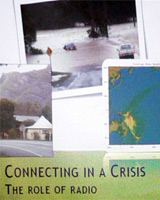Building disaster resilience of Pacific radio stations
08-09-2010 (Apia)

Presentation at the workshop
© AIBD
The Pacific Media Partnership and Development Forum, organized by the Asia-Pacific Institute for Broadcasting Development (AIBD) in Nuku’alofa (Tonga) during the last week of August 2010, provided the platform for a two-day UNESCO training workshop on disaster risk management (DRM).
The workshop, facilitated by Anthony Frangi of the School of Journalism and Communication at the University of Queensland, targeted radio managers, news editors and broadcasters. A total of 19 participants from the Cook Islands, Fiji, Samoa, Solomon Islands, Papua New Guinea, Vanuatu and the host country, Tonga, attended the training.
“Radio stations are a vital link in the communication chain for Pacific islanders,” Mr Frangi said, “Anyone working in radio who find himself in a natural disaster, such as a cyclone, tsunami or earthquake, should be fully prepared”.
The training focused on skills that could be implemented immediately. A particular emphasis was made on supporting radio managers in creating and implementing in-house DRM plans, in developing and rolling out in-house training as well as in delivering content that assists communities in the pre- and post-disaster phases. As the facilitator pointed out, “during a disaster your role of broadcaster will make a difference to the affected community.”
Attention was also paid to the use of new portable transmission equipment that enables radio stations to remain on the air, even under very difficult circumstances. An example is the radio-in-a-box, which UNESCO has developed in cooperation with the Asia-Pacific Broadcasting Union (ABU).
Delegates from across the Pacific also shared their own stories about covering natural disasters and the need to broadcast up-to-date and accurate information quickly, frequently and efficiently.
Two follow-up national training events targeting local communities and emergency services will be held later this year in the Solomon Islands and Vanuatu.
For further information on this story you may contact:
Anthony Frangi, School of Journalism and Communication, University of Queensland
“Radio stations are a vital link in the communication chain for Pacific islanders,” Mr Frangi said, “Anyone working in radio who find himself in a natural disaster, such as a cyclone, tsunami or earthquake, should be fully prepared”.
The training focused on skills that could be implemented immediately. A particular emphasis was made on supporting radio managers in creating and implementing in-house DRM plans, in developing and rolling out in-house training as well as in delivering content that assists communities in the pre- and post-disaster phases. As the facilitator pointed out, “during a disaster your role of broadcaster will make a difference to the affected community.”
Attention was also paid to the use of new portable transmission equipment that enables radio stations to remain on the air, even under very difficult circumstances. An example is the radio-in-a-box, which UNESCO has developed in cooperation with the Asia-Pacific Broadcasting Union (ABU).
Delegates from across the Pacific also shared their own stories about covering natural disasters and the need to broadcast up-to-date and accurate information quickly, frequently and efficiently.
Two follow-up national training events targeting local communities and emergency services will be held later this year in the Solomon Islands and Vanuatu.
For further information on this story you may contact:
 Workshop participants
Workshop participants© AIBD
Related themes/countries
· Asia and the Pacific
· Public Service Broadcasting
· Training of Media Professionals
· Weekly newsletter
Share this story:
Contact information
- UNESCO
Source














